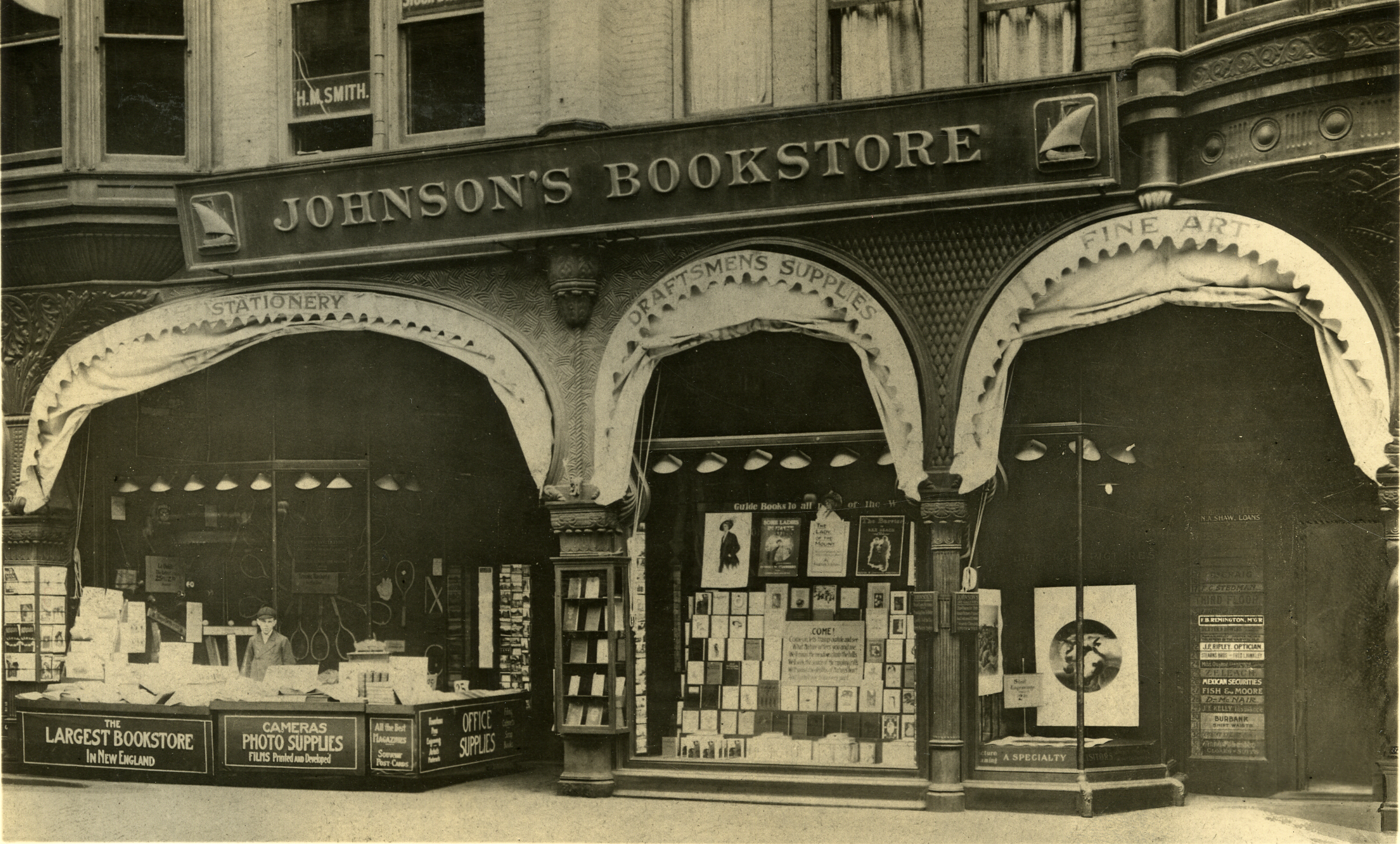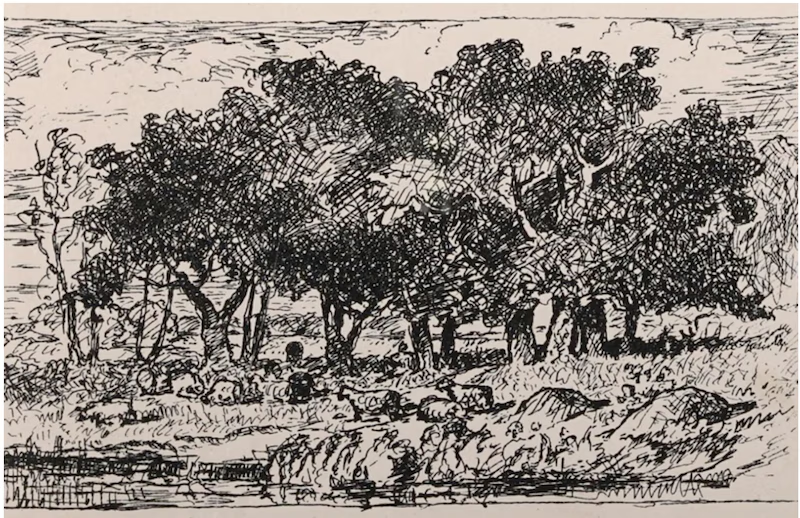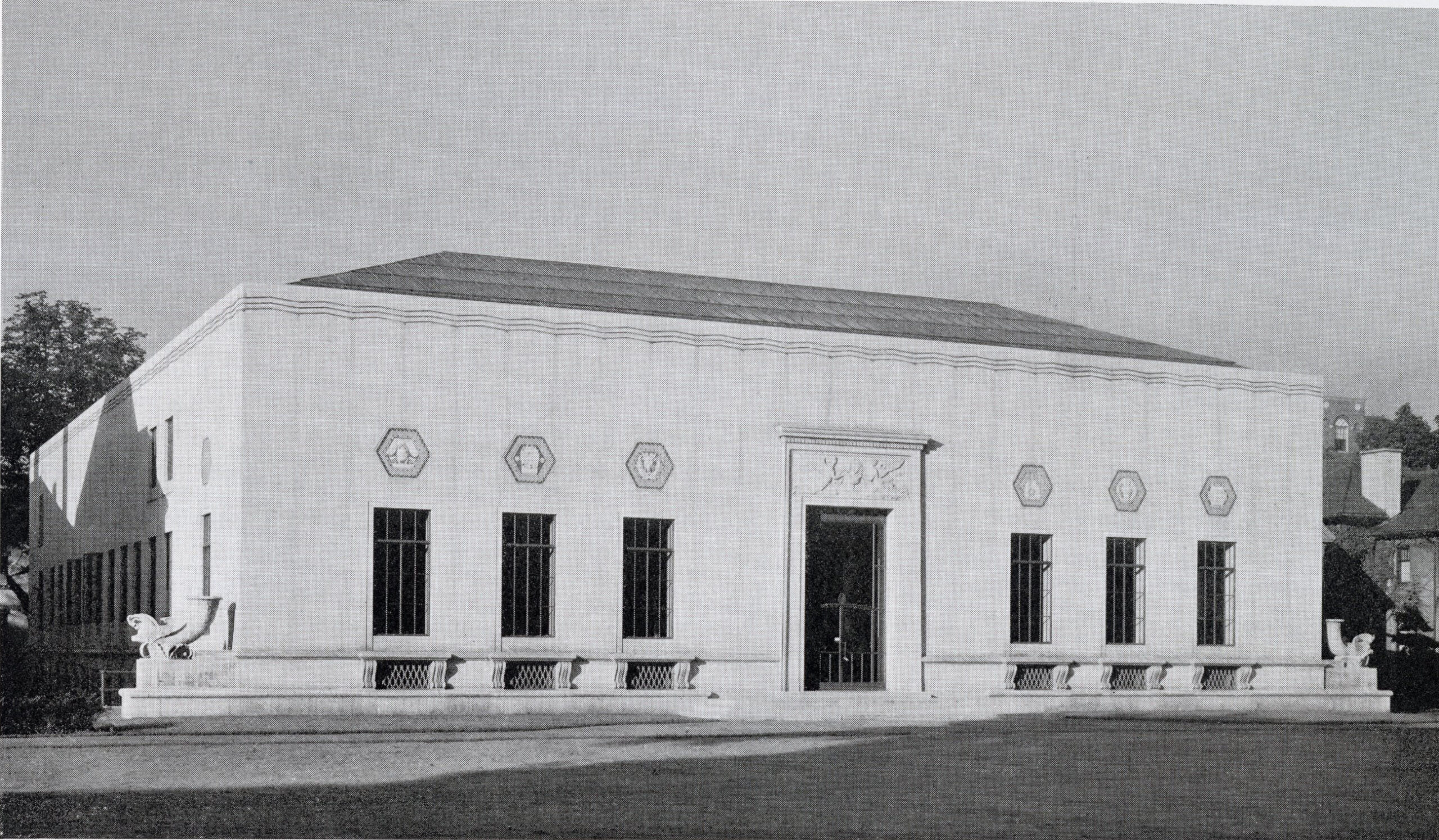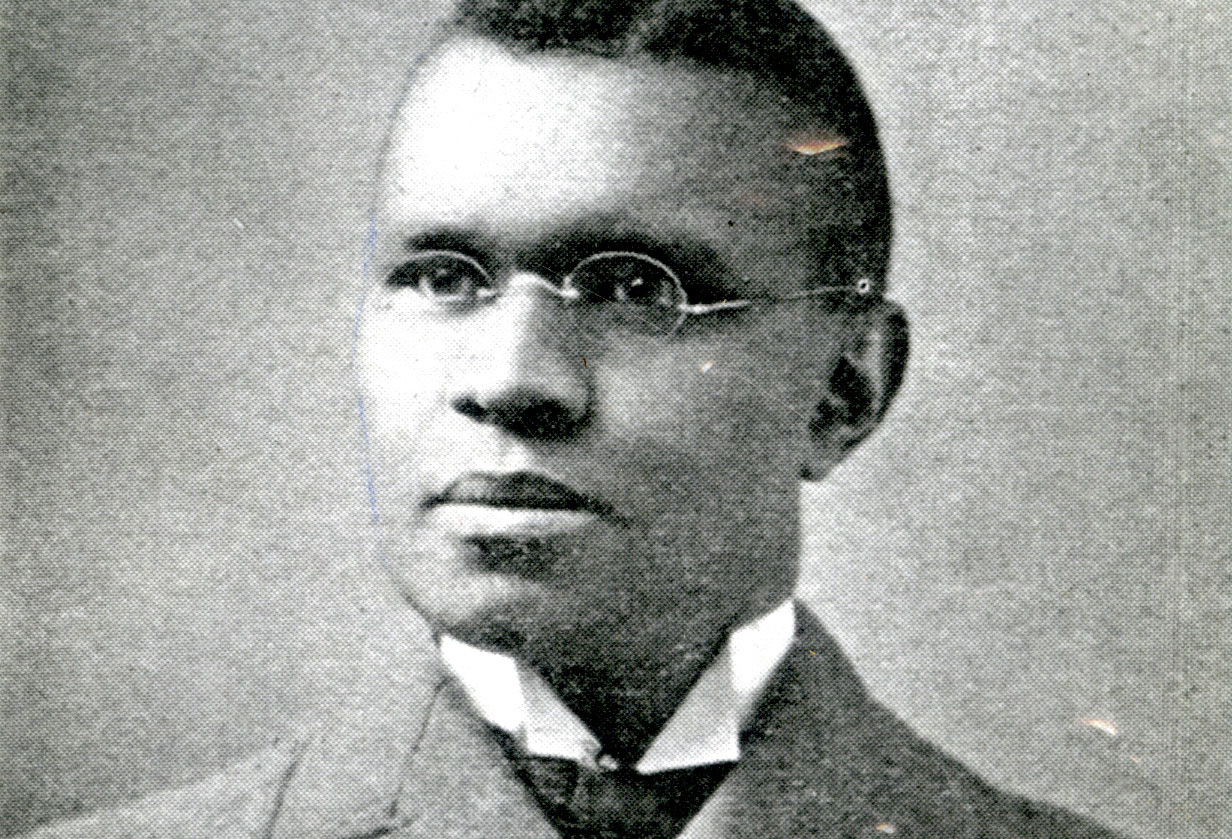
Johnson’s Bookstore, A History
Johnson’s Bookstore, an iconic Main Street institution in Springfield, Massachusetts, for over a century, was established by Henry R. Johnson in 1893. It was owned and managed by four generations of the Johnson family until its closing in 1997. Over its lifetime the store occupied five successively larger Main Street locations, all within a few blocks of each other. It was one of the largest independent booksellers in New England and its store letterhead and advertising reflected that, reading “Johnson’s Bookstore, The Largest Store of Its Kind in New England.” It was a favorite haunt for many people of all ages who lived in the Springfield area. A trip downtown to shop at the city’s department stores was often paired with a visit to Johnson’s to look at the books, toys, and gifts. As those department stores closed, Johnson’s became a destination in itself.
Henry Reynolds Johnson was born to Chester L. and Jeannette Reynolds Johnson in “the long, lazy hamlet of Hockanum,” a part of Hadley, Massachusetts, on April 7th, 1868. He was the youngest of three brothers; Clifton was born in 1865 and Charles was born in 1867. He also had a younger sister, Jeannette, born in 1872. Henry followed in his oldest brother Clifton’s footsteps, attending the same village school, followed by enrollment in Hopkins Academy in Hadley. Clifton dropped out of school in 1880 at age 15. He rowed across the Connecticut River and walked into Northampton, a distance of over two miles. He got a job at the College Bookstore, in order to pay off the mortgage to prevent foreclosure on the family farm. His brother, Henry, also dropped out of school at the age of 16 in 1885 and went to work at the same store to help pay off that debt. After a two and a half year apprenticeship there, Henry came to Springfield to take a position at James D. Gill’s prestigious book, stationery and art store at the corner of Bridge and Main Streets.
 Henry spent five and a half years working for Gill before deciding to go into business for himself. In April 1893, using his savings, and those of his oldest brother, Clifton, he purchased a small stationery and notion shop from Miss S. I. Cooley at 318 Main Street. The sign over the storefront of the 800 square foot shop read Henry R. Johnson’s Blank Books. Johnson employed a staff of two, one clerk and a boy, and sold bookkeeping supplies, stationery, and “kindred supplies.” A fire next door required the removal of the business to a half store at 428 Main Street. As business increased, Johnson moved to more spacious quarters encompassing 1,500 square feet at the southwest corner of Main and Vernon Streets. The staff grew to twenty employees, and in March 1898 Henry Johnson relocated once again to a large double store of over 10,000 square feet in the Fuller Building, currently the location of Public Radio’s NEPR station, at 313-315 Main Street. Here he sold books, art supplies, stationery and office supplies. He also maintained an art gallery in conjunction with Edward Walton, who managed the art supplies department. Through the first decade of the twentieth century the Johnson-Walton Galleries, within the bookstore premises, had an annual exhibition of oil paintings by American artists, along with exhibitions of work by individual artists. Later it loaned paintings to James Gill for his exhibitions. During this period, the staff again doubled, increasing to forty employees.
Henry spent five and a half years working for Gill before deciding to go into business for himself. In April 1893, using his savings, and those of his oldest brother, Clifton, he purchased a small stationery and notion shop from Miss S. I. Cooley at 318 Main Street. The sign over the storefront of the 800 square foot shop read Henry R. Johnson’s Blank Books. Johnson employed a staff of two, one clerk and a boy, and sold bookkeeping supplies, stationery, and “kindred supplies.” A fire next door required the removal of the business to a half store at 428 Main Street. As business increased, Johnson moved to more spacious quarters encompassing 1,500 square feet at the southwest corner of Main and Vernon Streets. The staff grew to twenty employees, and in March 1898 Henry Johnson relocated once again to a large double store of over 10,000 square feet in the Fuller Building, currently the location of Public Radio’s NEPR station, at 313-315 Main Street. Here he sold books, art supplies, stationery and office supplies. He also maintained an art gallery in conjunction with Edward Walton, who managed the art supplies department. Through the first decade of the twentieth century the Johnson-Walton Galleries, within the bookstore premises, had an annual exhibition of oil paintings by American artists, along with exhibitions of work by individual artists. Later it loaned paintings to James Gill for his exhibitions. During this period, the staff again doubled, increasing to forty employees.
Henry Johnson was a true Yankee with an eye for a bargain, boundless energy, and a flair for marketing. In his early days in business, he published humorous ads in the local newspapers, followed later by more merchandise-driven ads to promote his store. Johnson’s store windows were always eye-catching, topical and creative. This marketing flair was carried on by later generations, with the bookstore windows on Main Street featuring everything from live bunnies, puppies, baby chicks, a juggling clown, an old automobile complete

with road maps, and even a group of boys playing marbles in the window. At Christmas an electric train ran all day long in the main window.
In 1909 the store moved a final time, finding its permanent location in the Charles Hall Building, renamed the Bookstore Building, at 391-395 Main Street. Due to street renumbering along Main Street in the 1920s that address became 1379 Main Street. At this time, the store’s name was changed to Johnson’s Bookstore. A booklet was issued to the public for the store’s opening, illustrated with photos and diagrams, which described with pride the new Johnson’s Bookstore. Its inventory, along with stationery, office supplies, and books, included cameras and leather goods on the main floor, a full toy department in the basement, and on the second floor, sporting goods, artists’ materials, draftsmen’s supplies, and a large selection of framed pictures.
In 1914 a rear building was constructed on Market Street directly behind  the Main Street store to house the Art Department. When Henry Johnson was planning the rear building he was considering an air walk connection, for which his family found a blueprint, or a tunnel. The tunnel was decided on, and ran under the street, connecting the two buildings so customers and staff could access both without going outside.
the Main Street store to house the Art Department. When Henry Johnson was planning the rear building he was considering an air walk connection, for which his family found a blueprint, or a tunnel. The tunnel was decided on, and ran under the street, connecting the two buildings so customers and staff could access both without going outside.
In 1919 Johnson’s started a new tradition; a special guest book was designated to record the signatures and comments of famous individuals who visited the store. Naturalist John Burroughs was the first to sign the book in March 1919, followed soon after by children’s author Thornton Burgess and poet Robert Frost. Actor/singer/activist Paul Robeson and author Joseph Conrad autographed the book, along with famed Irish tenor John McCormack, TV personality Art Linkletter, broadcaster Lowell Thomas, and many others. On Christmas Eve of 1937 Theodor Seuss Geisel, Springfield’s own Dr. Seuss, was spending the holidays in the city and added his signature to the book, echoing the sentiments of Albert Payson Terhune, another Springfield native and author. Under the Remarks section Geisel wrote “see remark by Albert Payson Terhune, who, next to his signature 2 lines above, had written “Once a Springfield boy. Now a third rate writer.” This custom of capturing the names of special shoppers continued until 1964, and became one of the store’s most prized possessions.
After WWI an Antiques Department and a secondhand bookshop were  added. The secondhand bookshop, considered a hobby for Henry Johnson after his retirement, was opened in 1921. It soon became a popular spot for Johnson’s shoppers. Separate departments were also created for greeting cards and gifts.
added. The secondhand bookshop, considered a hobby for Henry Johnson after his retirement, was opened in 1921. It soon became a popular spot for Johnson’s shoppers. Separate departments were also created for greeting cards and gifts.
Since the store’s opening in 1893, Clifton Johnson had been a silent partner and trusted advisor to his brother Henry. The two men were close, and Clifton came down from Hadley and spent every Tuesday and Friday at the store in Springfield when he wasn’t traveling to do research for his own books. Clifton’s career path was that of author, illustrator and photographer. He wrote, edited, and/or illustrated more than 125 books. He designed the store’s familiar ship logo, which was a rendering of a shallop, a boat used on the Connecticut River by early settlers coming up from Wethersfield, Connecticut. This instantly identifiable logo appeared on Johnson’s “familiar green bags” for decades. Clifton Johnson passed away in Brattleboro, Vermont in 1940, but his connections to the bookstore were carried on by his sons, Roger and Arthur Johnson. Roger Johnson entered the business in 1918, followed a year later by his brother Arthur, who served in the Marine Corps in WWI. They became partners with their uncle, Henry Johnson, and bought control of the business from him in 1922. They helped to create the Antiques Department, which was stocked from buying trips Henry and his wife took throughout New England. In 1926 Richard Johnson, Henry’s son, entered the business and became active in its management in 1930.
Johnson’s Bookstore, with its unique stock of carefully chosen premium quality merchandise and its emphasis on customer satisfaction, continued to do well, even during the Depression of the 1930s. In 1936, when the banks of the Connecticut River overflowed and flooded Main Street, Johnson’s, like many stores on Main Street, suffered losses of a considerable amount of its stock in the basement sales space and stockrooms, where the flood waters reached almost six feet.
Henry Johnson’s buying of antique furniture became even more important during WWII because no new furniture was being made. He traveled extensively in New England, paying cash for people’s surplus furniture, and the store’s antique shop found a ready market among buyers from the stores in New York City. Roger Johnson, Treasurer and General Manager, remained in Springfield to run the book store while his brother, Arthur, the company Vice President, served in the United States Navy. It was a great regret of Roger’s that he didn’t serve in the military, but he was needed to run the store. Instead he became a patriotic proponent of the War effort on the home front. Johnson’s Bookstore hosted a Women’s Army Corp (WAC) recruiting office on the second floor of its building, and had a permanent War Bond booth in the store. War Bonds were very successfully promoted, with slogans like “Buying a $100 bond for $75 is like buying a Garand Rifle for our Troops.” The displays in the store’s Main Street window encouraged citizens to join the WAC, support the Red Cross, and buy War Bonds.
On April 7th, 1943, Henry Johnson celebrated his 75th birthday and the store had its 50th Anniversary. In lieu of hosting a large celebration and anniversary sale, given wartime food shortages and a limited supply of merchandise, Johnson’s gave a $2,500 donation to the Red Cross and formed a Benefit Fund for its Bookstore Crew of 75 employees. Although officially retired, Henry continued to enjoy the search in Massachusetts, Vermont, New Hampshire and Connecticut for antiques and secondhand books for the departments in the Rear Building. Following the war, Arthur returned to the store to join Roger and Richard, who by this time was Secretary and Assistant Treasurer of the store.
In 1948 Charles Johnson, Roger’s son, graduated from Amherst College and became the first of the third generation in the family business. Roger decided that Charlie would learn every aspect of the business so he started his career as one of the store’s night janitors, and spent the next two years working in every store department. He met his wife, Dorothy Allen, known as Dottie, while working at the store. Charlie and his wife were involved in running the store until it closed, and Dottie, with her style and excellent taste, joined the business as its merchandising manager in the 1970s. Peter Johnson, Henry Johnson’s grandson, and Richard’s son, was also a third generation family member who joined the store in 1965.
 During the 1950s Johnson’s Bookstore did a huge retail Christmas business. The annual Christmas parade down Main Street, held the Friday after Thanksgiving, was so popular the store had to put plywood panels up to protect its windows from being broken by the pressure of the crowds gathered to watch the parade. The store hired a couple of husky football players for traffic control because of the deluge of customers at their main entrance when the parade was over. Their Santa held court in the Toy Department from November 1st to Christmas Eve. To avoid Christmas morning disappointment, it was a store rule that the Johnson’s Santa never promised a child a toy unless the parents gave him the nod. At its peak in the 1950s, Johnson’s Santa handed out more than 25,000 of the store’s gold “lucky coins from Santa Claus” to the children who visited him. These coins were given out from the late 1940s through the 1960s and treasured by the children who received them. They are still a fond memory for many people who grew up in the Springfield area. In 1959 Henry Johnson, known as the Dean of Downtown, passed away at the age of 91, leaving his legacy in good hands.
During the 1950s Johnson’s Bookstore did a huge retail Christmas business. The annual Christmas parade down Main Street, held the Friday after Thanksgiving, was so popular the store had to put plywood panels up to protect its windows from being broken by the pressure of the crowds gathered to watch the parade. The store hired a couple of husky football players for traffic control because of the deluge of customers at their main entrance when the parade was over. Their Santa held court in the Toy Department from November 1st to Christmas Eve. To avoid Christmas morning disappointment, it was a store rule that the Johnson’s Santa never promised a child a toy unless the parents gave him the nod. At its peak in the 1950s, Johnson’s Santa handed out more than 25,000 of the store’s gold “lucky coins from Santa Claus” to the children who visited him. These coins were given out from the late 1940s through the 1960s and treasured by the children who received them. They are still a fond memory for many people who grew up in the Springfield area. In 1959 Henry Johnson, known as the Dean of Downtown, passed away at the age of 91, leaving his legacy in good hands.
By the store’s 75th Anniversary in 1968, the main floor of the Main Street store was devoted to new books, the greeting card department, pens and leather goods. Office supplies, the genesis of the Johnson family business, were relocated to a larger space in the basement along with the Toy Shop. With the departure of the Bookshop Restaurant, the Rear Building became the art shop and framing gallery. During this period the store also carried sporting goods, including gym sets, above ground pools, bicycles, skis, sleds, toboggans, ice skates, and tennis racquets. Electric trains, radios and cameras were also sold. All this varied inventory led some customers to refer to Johnson’s as the “non-clothing department store.” The second floor housed the second hand bookshop, a fascinating repository of books, posters, and old magazines. A fourth generation of the Johnson family joined the store when in 1975 Paul Johnson, Clifton’s great grandson, and Charlie’s son, came on board. The store had grown to 40,000 square feet, spread over three buildings, and employed 125 people during the year and doubled to 250 employees at Christmas.
 In 1980 the name of Johnson’s Bookstore was changed to “Johnson’s Since 1893,” reflecting the fact that the store retailed so much more than just books. But the fabric of downtown Springfield was changing. Despite numerous efforts at downtown revitalization, the department stores and specialty shops on Main Street had begun to close, starting in 1976 with Forbes & Wallace, one of Springfield’s major department stores. Bay State West, now Tower Square, opened as an office tower and indoor mall in 1970, pulling business from Main Street to its enclosed retail space. Steiger’s Department Store was the last of Main Street’s major retailers to close in 1994.
In 1980 the name of Johnson’s Bookstore was changed to “Johnson’s Since 1893,” reflecting the fact that the store retailed so much more than just books. But the fabric of downtown Springfield was changing. Despite numerous efforts at downtown revitalization, the department stores and specialty shops on Main Street had begun to close, starting in 1976 with Forbes & Wallace, one of Springfield’s major department stores. Bay State West, now Tower Square, opened as an office tower and indoor mall in 1970, pulling business from Main Street to its enclosed retail space. Steiger’s Department Store was the last of Main Street’s major retailers to close in 1994.
In 1993 Johnson’s celebrated its Centennial with much fanfare. Always a family-run business, its hundred years of success on Main Street was based on responding to market trends, continually upgrading its facilities, and most importantly, setting high standards and continually training its staff to deliver the optimum shopping experience. The Johnson family prided itself on working together to deliver the most responsive customer experience, and having a visible family member on the premises to interact with staff and shoppers. By the early 1990s sales of new and used books accounted for about one third of the store’s revenue, followed by office supplies at just under 25%. Greeting cards, gifts and toys accounted for the rest of their sales. But Johnson’s was feeling the effects of the advent of national retailers like Borders and Barnes & Noble who lured customers away from the more service-oriented small retailers by undercutting traditional pricing. In 1995 the Annex closed and all the bookstore departments were consolidated under one roof for the first time since 1914. From its staffing peak of over 100 employees, the store found itself in 1997 with a staff of 16. By September that year Johnson’s announced that it would be closing its doors. Like many independent book stores, it could not compete with the change in consumer shopping habits, not only geographically from Main Street to the suburban malls, but also from full-service to discounter with limited merchandise. Its closing was met by an onslaught of letters from loyal customers deeply saddened by the news that a store which had been such a part of their lives for decades was shutting its doors. That final Christmas in 1997 the remaining cache of gold “lucky coins from Santa Claus” held over for decades, was handed out for the last time. The store’s original Santa suit from the 1930s was auctioned for charity. Johnson’s final day of business was January 5th, 1998.
—
Researched and written by Maggie Humberston, Curator of Library and Archives at the Springfield Museums, and Zoe Cheek, processor of the Johnson’s Bookstore Collection. Edited by Charlie Johnson.
All images courtesy of the Johnson’s Bookstore Collection, donated by Charles Johnson, and processed with the generous support of members of the Johnson family.



